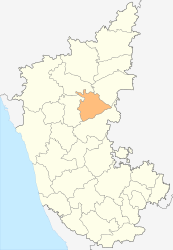Koppal (district)
| Koppal District ಕೊಪ್ಪಳ ಜಿಲ್ಲೆ |
|
|---|---|

|
|
| State | Karnataka |
| Division : | Gulbarga |
| Administrative headquarters : | Koppal |
| Area : | 5,565 km² |
| Residents : | 1,391,292 (2011) |
| Population density : | 250 inhabitants / km² |
| Website : | koppal.nic.in |
The district of Koppal ( Kannada : ಕೊಪ್ಪಳ ಜಿಲ್ಲೆ ) is a district of the Indian state of Karnataka . The administrative seat is the eponymous city of Koppal .
geography
The district of Koppal is located in northern Karnataka. Neighboring districts are Bellary in the south, Gadag in the west, Bagalkot in the northwest and Raichur in the northeast.
The area of the Koppal district is 5,565 square kilometers. The district area belongs to the highlands of Dekkan and is mostly a flat plateau with an average height of 400 to 600 meters above sea level. In the south, the Tungabhadra , one of the largest rivers in Karnataka, forms the border with the Bellary district. The climate in the Koppal district is hot and dry. Because of its location in the center of the Dekkan Plateau, Koppal receives only small amounts of rain during the southwest monsoon . The average annual precipitation is correspondingly low at 572 millimeters.
The Koppal district is divided into the four taluks Yelbarga, Kushtagi, Gangawati and Koppal.
history
The area of Koppal belonged to the nominally independent princely state of Hyderabad during the British colonial period . After Indian independence in 1947, Hyderabad was incorporated as a federal state in India. When the Indian states were reorganized by the States Reorganization Act in 1956 , the southwestern part of Hyderabad with the area of Koppal came to the state of Mysore created after the language borders of the Kannada (renamed Karnataka in 1973 ). As an independent district, the Koppal district was separated from the Raichur district in 1998 .
population
According to the 2011 Indian census, the Koppal district has 1,391,292 inhabitants. Between 2001 and 2011, the population grew by 16.3 percent, which is roughly the same as the average in Karnataka (15.7 percent). The district of Koppal is characterized by rural areas: the population density of 250 inhabitants per square kilometer is below the state average (319 inhabitants per square kilometer). 16.8 percent of the district's population live in cities. The proportion of the city's population is one of the lowest in Karnataka and less than half the state mean (38.6 percent). At 67.3 percent, the literacy rate is well below the average in Karnataka (76.1 percent).
According to the 2001 census, Hindus make up the vast majority of the residents of the Koppal district at 87.1 percent. There is also a Muslim minority of 11.5 percent. The 2001 census classified 11.6 percent of the district's residents as members of the tribal population (cf. Adivasi ). These are almost exclusively members of the Naikda .
Attractions
The place Anegundi in the south of the district Koppal lies on the bank of the Tungabhadra river directly opposite of Hampi , the former capital of the Vijayanagar empire (14th to 16th century). While the town of Hampi and the monuments belonging to the Hampi World Heritage Site are located on the southern bank of the river in the neighboring district of Bellary , a smaller part of the ruins of the former city is also north of Tungabhadra in the area of the Koppal district. The main attractions on the north side of the river are the hills Anjaneya Hill with a temple of the monkey god Hanuman , said to have been born here the Hindu According faith, and a small pond with the Ramayana mythical mentioned -Epos Lake Pampa Sarovar is identified .
Mahadeva Temple is located in the village of Itagi in the Koppal district. Built in 1112 during the rule of the Western Chalukya , it is considered to be one of the most important examples of late Chalukya architecture. Further sights in the district of Koppal are the place Kanakagiri with a temple from the Vijayanagar period and the Fort Koppal in the district capital Koppal .
Cities
| city | Population (2001) |
|---|---|
| Gangawati | 93,249 |
| Koppal | 56,145 |
| Kushtagi | 21,180 |
| Munirabad Project Area | 8,113 |
| Yelbarga | 11,437 |
Individual evidence
- ^ Koppal District website: District Profile. ( Memento of the original from March 15, 2012 in the Internet Archive ) Info: The archive link was inserted automatically and has not yet been checked. Please check the original and archive link according to the instructions and then remove this notice.
- ↑ Census of India 2011: Provisional Population Totals: Data Sheet (PDF; 1.7 MB) and Population and decadal growth rate by residence Persons. (PDF; 1.3 MB)
- ^ Census of India 2001: Basic Data Sheet. District Koppal (07), Karnataka (29). (PDF; 55 kB)
- ↑ Census of India 2001: Population, population in the age group 0-6 and literates by sex - Cities / Towns (in alphabetic order) ( Memento from June 16, 2004 in the Internet Archive )

